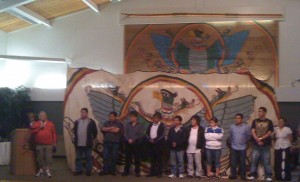This past week I have been participating in a week long seminar hosted by the School for Advanced Research in Santa Fe. Organized by Ben Columbi (Arizona) and SAR President James Brooks, our seminar has been discussing the linkages, threats, possibilities for the ‘people of the salmon’ from the Columbia River Basin through BC and Alaska to Kamchatka, Russia.
In addition to our seminar discussions we have also had the good fortune to learn a bit about the world surrounding us with a trip to the Pecos National Monument and the Lisboa Springs State fish hatchery earlier this week. The park sign warning of snakes caught my attention. The necessity of posting such a sign documents both an interest in our environment and the ways in which our contemporary society has progressively disengaged us from an understanding of our immediate environments.
Our session has been discussing the various ways in which our human societies have had this sort of direct connection; how these connections are being broken, but also -and more importantly- how we might envision a future in which we regain a meaningful connection with the world within which we live.



